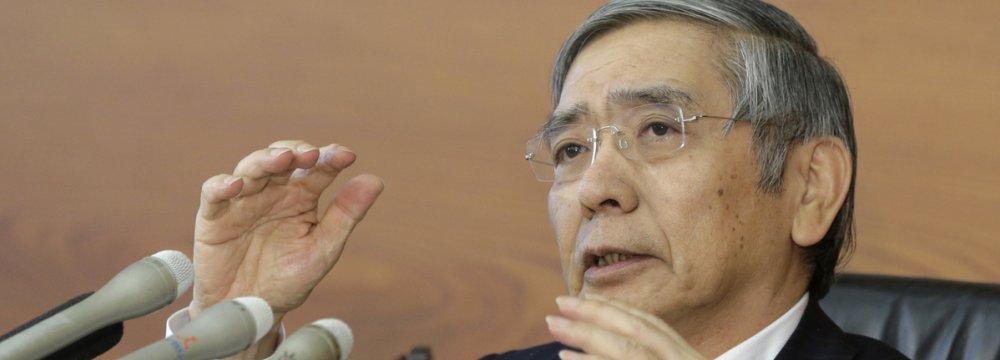The Bank of Japan shifted the focus of its monetary stimulus Wednesday from expanding the money supply to controlling interest rates, which some economists deemed as further evidence that BoJ policy had reached the limits of its effectiveness.
The central bank said it would adjust the volume of its asset purchases, the core of its framework until now, as necessary in the short term to control bond yields, while keeping it at about 80 trillion yen ($780 billion) annually over the long term. The BoJ also scrapped a target for the average maturity of its holdings of government bonds, Bloomberg reported.
The changes will help the BoJ manage the impact of its purchases and negative interest rates on Japanese banks, whose profits have been squeezed by a narrowing of short-term and long-term yields. Governor Haruhiko Kuroda and the policy board kept that negative rate, imposed on a share of bank reserves, unchanged at minus 0.1%.
Yuichi Kodama, chief economist at Meiji Yasuda Life Insurance Co. in Tokyo, saw the shift as a tacit admission by the BoJ that it has reached the limits of its JGBs purchases. The BoJ now owns more than a third of outstanding JGBs, with the pace of its buying draining the market of supply.
“If it takes additional easing in the future, it will probably deepen the negative rate,” he said.
New Measures
Kuroda said the BoJ hadn’t reached the limits of its bond purchases, and that the new measures strengthened the previous framework instead of scrapping it. An excessive flattening of the yield curve could harm the economy, he said during a news conference.
“As for the amount of government bond purchases, it could increase or decrease, as it relates to the economy, prices and in particular the financial markets,” he said.
The yen weakened against the US dollar before reversing to trade at 101.76 in Tokyo. Japanese shares rose the most since July, with the Topix index 2.7% higher at the close.
Japan’s 10-year government bond yields hit positive territory for the first time since March. The 10-year JGB yield was at minus 0.035% on Wednesday in Tokyo, after climbing to as high as 0.005% from minus 0.065% Tuesday, according to Japan Bond Trading Co.
Easing Rate Impact
The BoJ faced a backlash after first deploying negative rates in January. Bank shares tumbled at the time, the yen gained strength and household sentiment worsened.
Kuroda recently acknowledged that negative rates had cut into financial institutions’ profits by driving long-term yields lower, while pointing out that borrowing costs for businesses and consumers had also fallen.
He also expressed concern about expected declines in returns on insurance and pension products, and the impact this could have on people’s confidence.
“The BoJ’s decision to steepen the yield curve showed they are taking into account the situation of financial institutions,” said Takeshi Minami, chief economist at Norinchukin Research Institute.
Shares in Japanese banks surged as investors bet that the BoJ’s new framework would be less likely to erode commercial banks’ profits. The 87-stock Topix Banks Index surged 7%, the most since July 29, after the policy announcement. Mitsubishi UFJ Financial Group Inc., the nation’s largest lender, jumped 7.4%.
Policy Review
The BOJ has been the most daring of global central banks in using monetary stimulus to confront deflationary pressures and stagnation, but Kuroda recently began to publicly weigh the costs of its extraordinary easing against the benefits, a shift from his “whatever-it-takes” approach of the past three-plus years.
The decisions announced Wednesday followed a comprehensive review of its policies to assess their effectiveness and determine how to reach its distant 2% inflation target. They signal that the BoJ has taken a longer-term view of “reflating” Japan’s economy, and is focused for now on tweaking its policy framework with sustainability in mind.
The BoJ strengthened its forward guidance by pledging to continue expanding the monetary base until inflation is stable above the 2% target—committing to an overshoot of consumer-price gains in an effort to revive inflation expectations.





